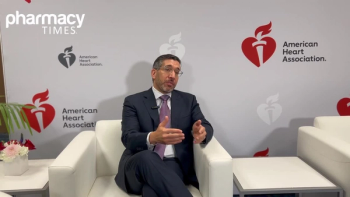
Boehringer Ingelheim Advances Cardio-Kidney-Metabolic Research Through Integrated Therapeutic Development
Boehringer Ingelheim showcases its commitment to cardio-kidney-metabolic research, highlighting innovative therapies and advancements at AHA 2025.
At the American Heart Association Scientific Sessions 2025 in New Orleans, Neerja Balachander, MBBS, PhD, discussed Boehringer Ingelheim’s long-standing commitment to advancing research and innovation across the cardio-kidney-metabolic spectrum. As a privately held, family-owned company with more than 140 years of experience in human and animal health, Boehringer Ingelheim’s focus remains on improving family and patient health rather than shareholder interests. Balachander highlighted the company’s pioneering role in studying empagliflozin for cardiovascular risk reduction and chronic kidney disease, helping to bridge the gap between cardiology, nephrology, and metabolic medicine. Building on this foundation, Boehringer Ingelheim continues to expand its research portfolio with agents such as survodutide, currently in development for obesity and metabolic-associated steatohepatitis (MASH), and other promising compounds targeting cardiovascular risk. The company remains dedicated to advancing therapies that address the interconnected nature of cardio-kidney-metabolic diseases to improve outcomes for patients worldwide.
Pharmacy Times: How does understanding the interconnected nature of heart and kidney health influence how we approach early intervention and long-term risk reduction for cardiovascular events?
Neerja Balachander, MBBS, PhD: All right, let’s look at what the kidney is. The kidney is a series of tiny little filters—1 million filters on each side—and each filter is made of a network of blood vessels, almost down to a single capillary level. Basically, it’s a series of blood vessels.
Now, when there is a leak or a problem with these blood vessels—whether they’re inflamed or stretched and strained, as can happen in diabetes—just like your tea filter having larger holes, they will start leaking protein. Albumin is a very small protein that all of us have in our blood; it’s the protein found in egg whites. When this starts to leak into the urine, it becomes one of the first signs of endothelial dysfunction.
Now, is this a disease of the heart or of the kidney? I would say it’s a disease of wherever there’s a blood vessel. Eventually, this will start to show in multiple organs, but because the kidney is such a window into this capillary network, we see it first. In fact, increasing research shows that if you have kidney disease, you are more likely to die of a heart attack or heart-related complication—six times more likely, in fact—than to end up on dialysis.
The worst part of all this is that nine out of ten patients with chronic kidney disease do not know they have it. The solution, however, is simple: measure the albumin-to-creatinine ratio in the urine. It’s an inexpensive test that can be done routinely, and it helps easily identify patients at risk. This test should be considered one of the key “risk enhancers,” just like blood pressure, diabetic status, cholesterol levels, and smoking history.
We have the ability to address cardio-kidney-metabolic risk—it just needs to be implemented. The first step is education; the second is implementation. For instance, in cardiology practice, it would be malpractice not to assess diabetic status or blood pressure. Yet we’ve grown distant from urine testing—it’s another example of medical silos.
Now, with increasing research and more publications, KDIGO has emphasized that albuminuria is a major risk factor being overlooked in cardiac disease. Primary care physicians are often overwhelmed, spending an average of only eight minutes per patient. If a patient walks in and says, “Doc, I’m depressed,” that alone can derail the visit’s agenda.
Given this, it falls upon us to make the process simple. The implementation science being done by the National Kidney Foundation (NKF), along with initiatives from the American Diabetes Association (ADA) and the American Heart Association (AHA), are moving in this direction. They’re partnering with organizations like ours—and with companies such as Boehringer Ingelheim and others—to develop a concise, actionable list of risk factors that clinicians and physicians can use effectively in everyday practice.
Pharmacy Times: Boehringer Ingelheim has been a leader in advancing therapies across the cardio-renal-metabolic spectrum. How do these efforts align with the company’s broader vision for improving patient outcomes?
Balachander: Such a great question. Boehringer Ingelheim is a privately held, family-owned company that has been bringing medications to humans and animals for the past 140 years. For us, this work is not about Wall Street or stock prices—it’s about family health. A majority of people around the world are suffering from cardio-kidney-metabolic conditions, and addressing those is a natural part of what we do next.
As you mentioned, Boehringer was one of the first companies to study empagliflozin for the reduction of cardiovascular risk. We then expanded our research to include chronic kidney disease, further bridging the cardio-kidney connection. Empagliflozin, originally developed as a diabetes medication, has become a key example of how treatments can address multiple organ systems within the cardio-kidney-metabolic continuum.
Now, with agents such as survodutide—currently being studied for obesity and metabolic-associated steatohepatitis (MASH)—and others like vicasatostat and empagliflozin, we are continuing to invest in cardiovascular risk reduction. We are firmly dedicated to advancing therapies across the cardio-kidney-metabolic space to improve patient health.
Newsletter
Stay informed on drug updates, treatment guidelines, and pharmacy practice trends—subscribe to Pharmacy Times for weekly clinical insights.






















































































































































































































